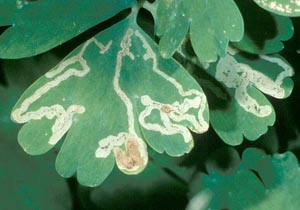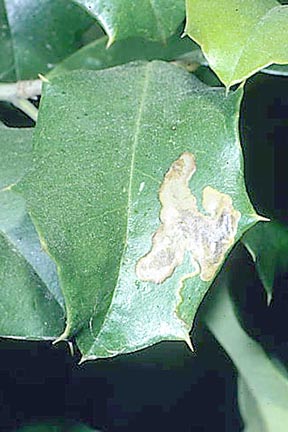Leafminers�� | |
|---|---|
| May 8, 2007 | |
|
Leafminer larvae live inside the leaves of many trees, shrubs, vines, and herbaceous plants. They feed on the mesophyll, the spongy and palisade cells between the upper and lower epidermises of the leaf. This environment within the leaf provides a moist area that is protected from at least some predators and parasites. As a result, many insect species have adapted to this lifestyle, including flies, moths, wasps, and beetles. With this being a popular way to make a living, a number of predatory and parasitic insects have also adapted to feeding on leafminers. The adult fly, wasp, moth, or beetle inserts its eggs into or onto the leaf tissue. Many leafminer adults also lay down a pheromone, a hormone produced outside of the body, that lets other leafminer adults know that this leaf or part of the leaf is already taken. As a result, a leaf commonly contains only a single leafminer, or the leafminers tend to be located at a distance from each other in the same leaf. The hatching larva tunnels through the leaf tissue, feeding on the mesophyll cells. In a leaf, chlorophyll is contained primarily in the mesophyll cells, causing leaves to be green. As these cells are eaten by the leafminer larva, whitish or light-colored areas appear because the remaining epidermal cells tend to be mostly transparent. With these epidermal cells being exposed to drying as the mesophyll cells are eaten away, they soon turn brown and die. Thus, recent mines are whitish and older mines are brownish, making it easy to tell whether the leafminer is still actively feeding. Holding a mined leaf up to the light makes it easier to see the entire mine, including smaller areas that were eaten when the larva was newly hatched. If the larva is still present, one can frequently see the silhouette of the feeding larva. Also obvious will be the fecal material deposited by the larva. One drawback of being a leafminer is that you are forced to live with your feces. Fully grown larvae chew their way through the leaf epidermis to the leaf surface and typically drop to the soil to pupate, although some moth larvae spin a cocoon and pupate on the leaf surface. With the diversity of insects that live as leafminers, the size and appearance of emerging, full-grown larvae vary. Those of flies and wasps are typically legless and usually 1/16 to 1/8 inch long. Many fly larvae are bright yellow, pink, or red when they emerge to pupate. Moth and beetle emerging leafminer larvae are typically legless as well, but are commonly 1/4 to 1/2 inch long. The adult emerges from the pupa to attack more leaves. Leafminers typically have more than one generation per year. Some leafminer flies have several generations per year. Because newly hatched leafminer larvae are very small, they tend to make small, narrow tunnels through the mesophyll. Some leafminer larvae continue to make narrow tunnels that meander through the leaf; they are referred to as serpentine leafminers. Their narrow, winding tunnels appear somewhat serpentlike, that is, snakelike. Columbine and honeysuckle leafminers are serpentine leafminers. The image shows columbine leafminer damage.  Other leafminers may form slender, snakelike tunnels initially but soon turn to feeding on the mesophyll cells in a broad area, resulting in what is called a blotch mine. Birch and holly leafminers are blotch leafminers. Blotch mines are commonly bounded by leaf veins, resulting in straight-sided mines. Other blotch mines cross leaf veins and become more rounded in shape. The image shows holly leafminer damage. Other leafminers may form slender, snakelike tunnels initially but soon turn to feeding on the mesophyll cells in a broad area, resulting in what is called a blotch mine. Birch and holly leafminers are blotch leafminers. Blotch mines are commonly bounded by leaf veins, resulting in straight-sided mines. Other blotch mines cross leaf veins and become more rounded in shape. The image shows holly leafminer damage.  Although leafminer damage is obvious, it usually has little effect on plant health. Although the mesophyll that is eaten does not produce sugars for the plant, the undamaged cells in the leaf continue to produce. An exception to that is when the leafmining is so extensive that it causes leaf drop. Birch leafminer is the only one that causes leaf drop in Illinois and only in the northernmost row of counties. Farther south, the damage is noticeable but not severely damaging. Holly leafminer may produce enough aesthetic damage in southern, particularly southeastern, Illinois to warrant control but rarely causes leaf drop. In states to the east and south, holly leafminer damage can be very severe. Systemic insecticides are recommended for control of both leafminers. Because leafminers typically have several generations per year, removing and destroying mined leaves while the larvae are still inside can reduce the number of mined leaves later in the season. Leaves that still have whitish mines should still contain the larvae; the larvae have usually already left the mines if the mines are brown. �� | |
| Author: | Phil Nixon |
